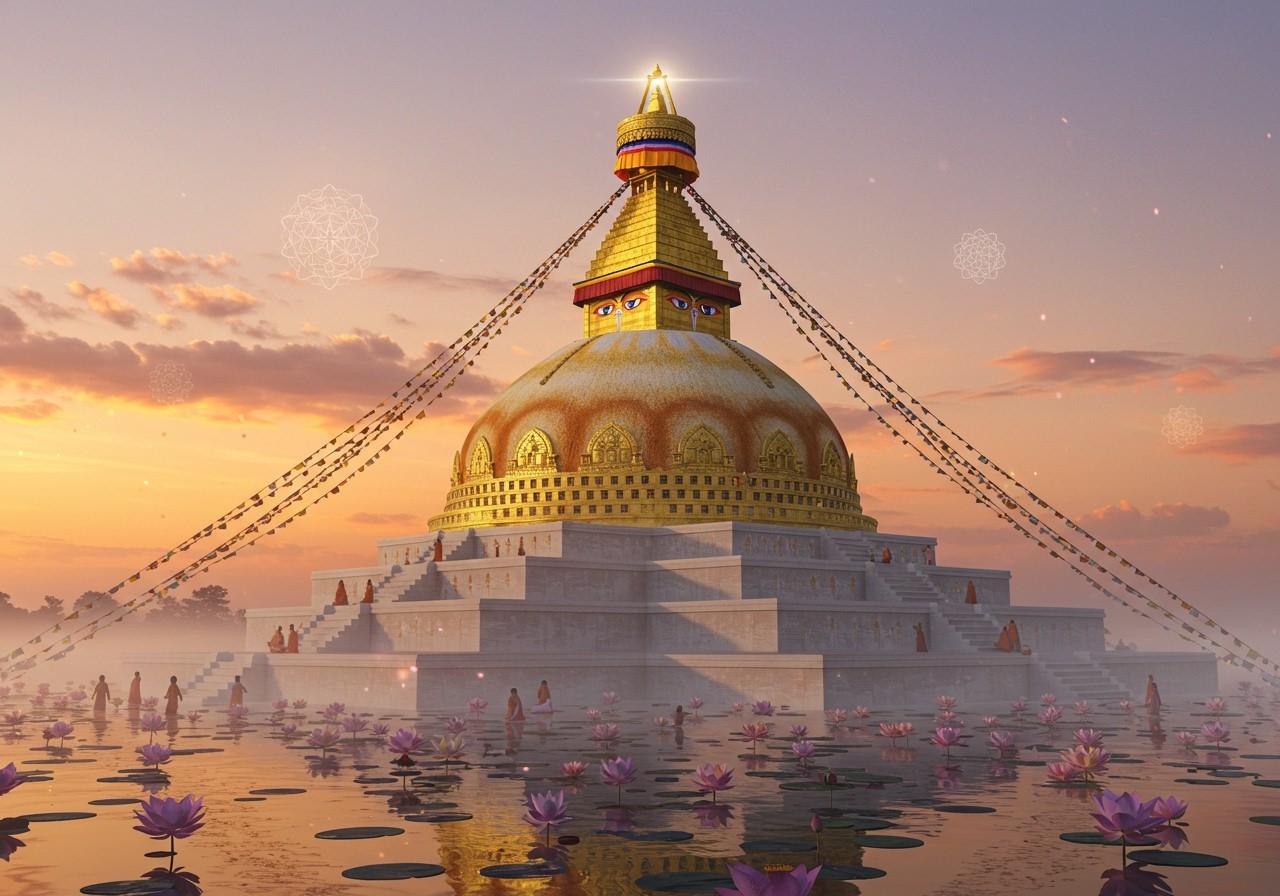
Buddhist stupas are profound monuments, carrying rich symbolism and intricate architecture. These structures hold deep cultural significance and spiritual meaning within Buddhism. They are revered for embodying the essence of Buddhist teachings and reflecting profound philosophical concepts.
Historical Background of Stupas
Stupas originated in ancient India, initially as burial mounds for relics of the Buddha and other important figures. Over time, these simple mounds evolved into elaborate architectural marvels. Key historical examples include the Sanchi Stupa and the Amaravati Stupa. Stupa architecture spread across Asia, influencing designs in Nepal, Tibet, and Sri Lanka. Local cultures and beliefs shaped variations in stupa designs, and these sacred structures play a vital role in Buddhist pilgrimage.
Symbolism of Stupas
Stupa architecture is rich in symbolic elements. The dome (anda), the base (medhi), and the pinnacle (chatra) each hold spiritual meaning. A stupa represents the Buddha’s path to enlightenment, with each component symbolizing different aspects of this journey. Cardinal directions in stupa design represent the Buddha’s universal reach, and the materials and colors used in construction also hold symbolic weight. Stupas serve as important tools for meditation and contemplation.
Architectural Features of Stupas
The layout of stupas incorporates various functional and symbolic parts, such as the harmika and torana. Architectural styles vary by region, with distinct forms like Tibetan chortens and Burmese zedis. Indian architectural principles, often employing geometric shapes and symmetry, heavily influence stupa designs. Stupa architecture frequently integrates with the natural landscape, enhancing its beauty and significance. Famous stupas showcase unique architectural features, reflecting the diverse interpretations of this sacred form.
Stupa vs. Pagoda
Stupas and pagodas, while both important in Buddhist architecture, have distinct differences. Pagodas originated in East Asia, particularly China and Japan. Architectural differences include variations in design, structure, and materials. While primarily Buddhist, pagodas also have connections to Taoism and Shintoism. Both stupas and pagodas share symbolic meanings but also possess unique distinctions. Famous pagodas offer valuable historical insights.
Contemporary Relevance of Stupas
Stupas remain important in modern Buddhist practice and spirituality. They are actively used in contemporary rituals, ceremonies, community gatherings, and festivals. Preservation and restoration efforts highlight their ongoing cultural significance. Stupa symbolism finds its way into modern architecture and art, demonstrating its enduring influence. Stupas promote cultural heritage and tourism, and new stupa constructions can positively impact local communities.
For up-to-date information on stupas, refer to recent search results. A stupa is a Buddhist commemorative monument that typically houses sacred relics associated with the Buddha or other saintly figures. Its hemispherical form is derived from pre-Buddhist burial mounds in India. Stupas serve as markers for sacred spaces and symbolize the Buddha’s burial mound. Architecturally, they consist of a circular base supporting a solid dome. The stupa is a significant form of Buddhist architecture, often serving as a sepulchral monument or a receptacle for religious objects. The design and symbolism of stupas have been adopted in Southeast and East Asia.
How Poojn.in Supports Your Connection to Stupa Traditions
At Poojn.in, we offer a curated selection of items to support your connection to Buddhist traditions and stupa worship:
- Pure brass butter lamps: Illuminate your stupa offerings with the warm glow of traditional butter lamps. These beautifully crafted lamps are perfect for creating a sacred atmosphere during prayers and rituals.
- High-quality incense and holders: Enhance your stupa rituals with fragrant incense offerings. Choose from a variety of scents and holders to create a serene and contemplative environment.
- Traditional prayer beads (mala): Deepen your meditation practice with authentic prayer beads crafted from sacred materials. Our malas are carefully made to support your spiritual journey.
- Copper and brass offering bowls: Make traditional water offerings at stupas with our elegant offering bowls. These durable and beautiful bowls add a touch of reverence to your practice.
- Prayer flags in authentic designs: Adorn your stupa or sacred space with vibrant prayer flags. These flags carry blessings and positive energy, enhancing the spiritual atmosphere.
These items are essential for traditional stupa worship practices and are available for convenient online purchase with delivery across India. Each product comes with proper authentication and quality assurance, ensuring you receive genuine ritual items that meet traditional standards.
Visit Poojn.in to explore our full range of Buddhist ritual supplies and have them delivered to your doorstep. Our customer service team can assist you in selecting the right items for your stupa-related practices and answer any questions about their proper usage.
Shop Buddhist Ritual Items at Poojn.in
Note: Product availability may vary. Please check the website for current stock and pricing.
Conclusion
Stupas are more than just architectural marvels; they embody deep spiritual and cultural significance. Their intricate designs and rich symbolism reflect the essence of Buddhist teachings and the path to enlightenment. From their historical origins to their contemporary relevance, stupas continue to inspire reverence and respect. Whether encountered in ancient sites or modern settings, stupas serve as timeless reminders of the Buddha’s wisdom and the enduring power of faith. Embracing their beauty and meaning enriches our understanding of Buddhist traditions and their profound impact on culture and spirituality.
You may also be interested in the following articles from Poojn.in:
- Hindu Temple Architecture: Significance and Symbolism
- Hindu Sacred Architecture: Temples and Beyond – A Guide to Principles and Design
- Dravidian Temple Architecture: A Detailed Guide
And for your puja needs, consider these products:


